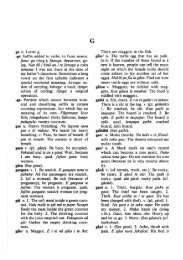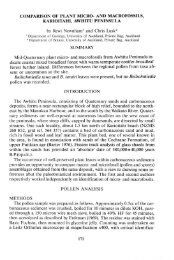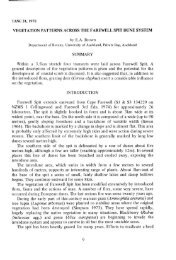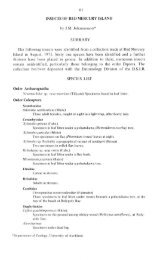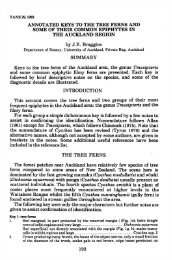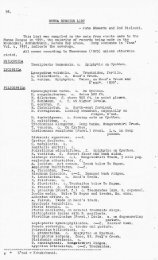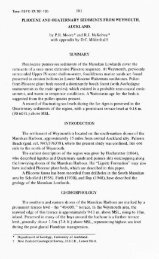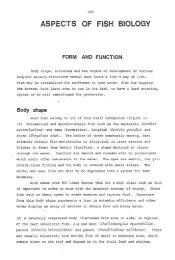METRES - Bookshelf Collection - The University of Auckland
METRES - Bookshelf Collection - The University of Auckland
METRES - Bookshelf Collection - The University of Auckland
You also want an ePaper? Increase the reach of your titles
YUMPU automatically turns print PDFs into web optimized ePapers that Google loves.
18<br />
anhedral clinopyroxene crystals, opaques and alkali feldspar constitutes between<br />
52 and 93% <strong>of</strong> the bulk composition <strong>of</strong> all sections. Small anhedral clinopyroxene<br />
crystals and opaques, <strong>of</strong> less than 0.3mm diameter, fill the angular interstices<br />
between the plagioclase microlites. <strong>The</strong> <strong>of</strong>ten indistinguishable colourless alkali<br />
feldspar occurs as a late crystallising phase in cavities between the plagioclase<br />
and clinopyroxene crystals.<br />
Coarseness and groundmass constituents is highly variable, with microlites<br />
generally less than 0.3mm in length, although 19987, with subophitic texture,<br />
contains some up to 0.6mm long.<br />
basalt.<br />
Rock type for all flows and dykes examined is considered to be an olivine<br />
(b) Tuff Beds<br />
Three samples from the tuff beds were examined. Colours vary from<br />
whitish through red-brown to dark brown, though all appear to be <strong>of</strong> similar<br />
composition. <strong>The</strong> whitish sample, however, consists <strong>of</strong> what seems to be highly<br />
weathered pumiceous material, with common euhedral to anhedral opaques<br />
and rare quartz grains. Some relatively unweathered darker scoriaceous fragments<br />
are also present.<br />
<strong>The</strong> other two samples consist largely <strong>of</strong> whitish and grey to red-brown rock<br />
fragments, <strong>of</strong>ten very glassy and vesicular, and common feldspar phenocrysts<br />
and abundant colourless to white glassy shards. <strong>The</strong> remaining fragments<br />
consist <strong>of</strong> both black and red-brown glass in varying amounts, minor black ores,<br />
and rare quartz grains. <strong>The</strong> red-brown glass shows a "grain" or sheen similar to<br />
that found in some <strong>of</strong> the obsidians <strong>of</strong> Mayor Island (pers. obs.).<br />
(c) Te Kokowai Intrusion<br />
One fresh specimen (19984) <strong>of</strong> the Te Kokowai Intrusion was sectioned and<br />
examined. <strong>The</strong> modal analysis is presented in Table 1. In hand specimens the<br />
sample is indistinguishable from the flows and dykes. It is light grey, vesicular,<br />
and with golden-brown phenocrysts <strong>of</strong> altered olivine, <strong>of</strong> maximum dimension<br />
1.5mm, scattered throughout.<br />
In thin section the rock is porphyritic although the phenocrysts, mostly<br />
iddingsite pseudomorphs after olivine, comprise only 5% <strong>of</strong> the bulk composition.<br />
Stubby subhedral poikilitic plagioclase phenocrysts are rare.<br />
<strong>The</strong> groundmass has an intergranular to intersertal texture <strong>of</strong> which 70%<br />
is indeterminable fine grained material <strong>of</strong> less than 0.01mm diameter. Slender<br />
plagioclase microlites, 0.05 to 0.2mm long, are the coarsest and most common<br />
groundmass mineral indentifiable, with very fine grained crystals <strong>of</strong> clinopyroxene<br />
rarely discernible. Opaques are in minor proportions, and small<br />
patches <strong>of</strong> alkali feldspar occur as late crystallising groundmass cavity fillings.<br />
GEOLOGICAL HISTORY<br />
During an undetermined period in Pliocene and/or lower Pleistocene, the<br />
Whakau Volcanics were erupted onto a terrestrial surface. <strong>The</strong> nearest centre <strong>of</strong><br />
activity appears to have been <strong>of</strong>f Ngatoka Puta Bay where a considerable



